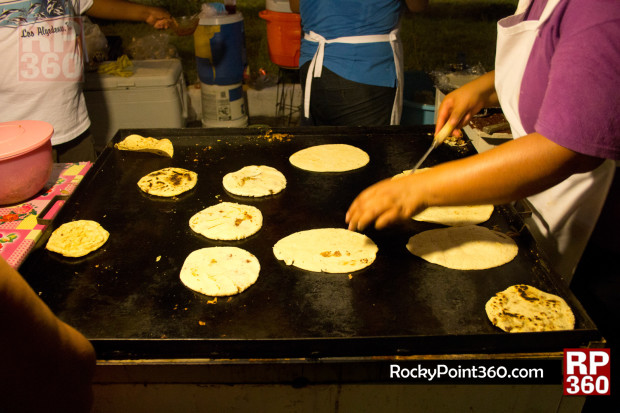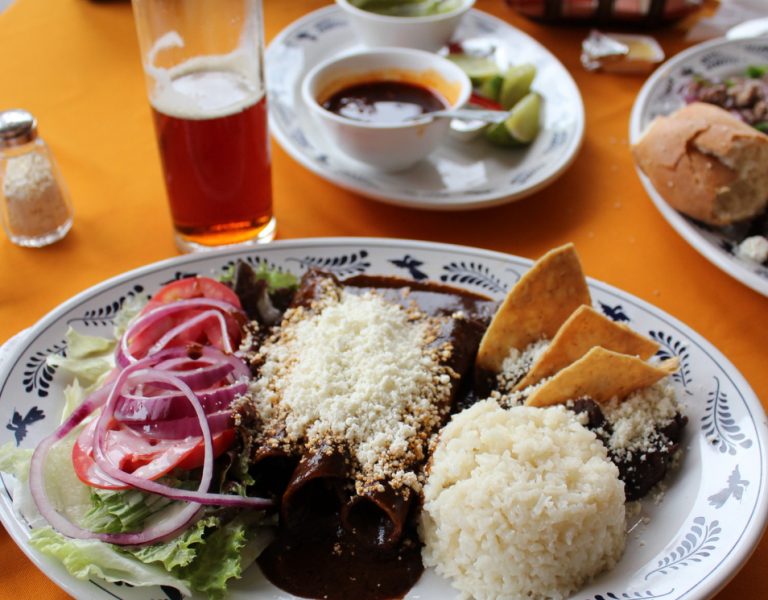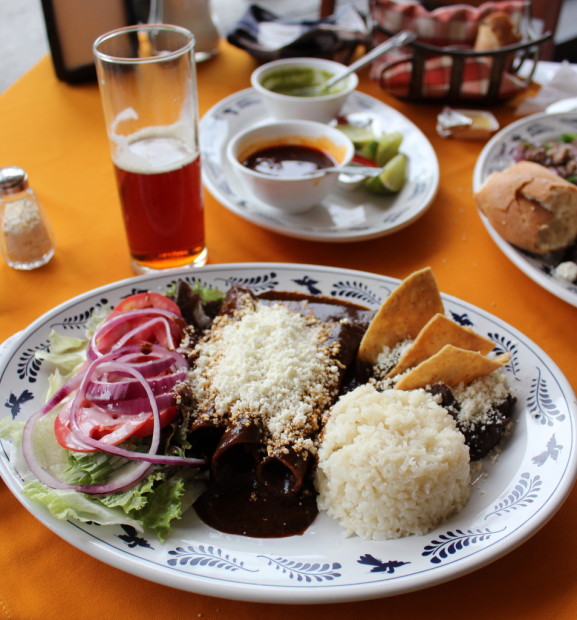By MoKa Hammeken
We’re well into September, the patriotic month for Mexicans! The month full of explosions of color and tastes! We’ve also had the famous long holiday weekend, “puente”, invigorating the hearts of the nation with fiestas streaming with tequila, sombreros, fireworks, and typical dishes.
 Who as a young child didn’t want to go to the traditional fiestas, shouting alongside their friends ¡VIVA MÉXICO!, served up with a dish of tostadas, tinga, guacamole, rajas con papa, pozole and other culinary delights?
Who as a young child didn’t want to go to the traditional fiestas, shouting alongside their friends ¡VIVA MÉXICO!, served up with a dish of tostadas, tinga, guacamole, rajas con papa, pozole and other culinary delights?
Yet, let’s be honest. If there’s one thing that’s intriguing to all and a mainstay at traditional fests, that’s mole (pronounced: MOL-lay). A good mole bounces off the palette, lending prestige to a home that will then forever be recognized and selected to bring the mole dish to fiestas; “So and so brings the mole” and there’s no turning back. Therefore, family recipes with supposed secret ingredients are jealously safeguarded.
Imagine the culinary rivalry! Some time ago I went to a Mole Fair in San Pedro Actopan (in the Valle de Mexico) and there were rows of restaurants, dives, and mole producers battling it out with tastings for passersby, vying for taste supremacy.
There were mole of all types, of all type of ingredients and the poor stomach could not seriously taste and eat each and every one. Even so, everything took place in respectful order. It’s worth noting the place smelled like heaven itself, with a combination of chiles, cacao, chicken broth, and other ingredients.
There I learned this dish is a piece of baroque art, combining tastes of prehispanic Mexico with that of the conquest. It is said the word Mole itself comes from Nahuatl mulli or molli, meaning “sauce” or “concoction”. Though there are those that affirm their grandmother and family created this singular dish (remember, there are moles of various types and from different regions), the official version apparently comes from the Santa Clara Convent in the city of Puebla, as mole poblano is recognized as one of the most traditional and delicious. Many people go to Puebla specifically as culinary explorers, trying the authentic moles, and of course visiting the city’s beautiful churches – but I digress.
It is often said the origin of the dish took place around 1700 A.D. when Sor Andrea de la Asunción, interned at the convent of Santa Rosa de Lima, began to seek a new dish that was dignified enough for the visiting Spanish viceroy, Don Thomas Antonio. Sor Andrea pulled together various ingredients, yet upon realizing the mixture was spicy she began to add other components such as cacao, almonds, and chocolate. It should be remembered at that time many indigenous women helped in the kitchen and surely contributed their knowledge of herbs, chiles, and other assorted spices. So, why not add a burnt tortilla? Or anis? Supposedly, traditional mole is a mixture of 4 chiles, 18 ingredients and turkey.
Legend says the name of mole comes by way of an error in pronunciation. The nuns, living under a vow of silence, suddenly began to perceive the rich aroma emitting from the kitchen. All the nuns left their activities in order to see where this utterly delicious aroma was coming from. Upon seeing it was coming from their own kitchen, the Mother Superior broke the vow of silence by saying “Sister, you “mol-lay” (mole) so well!”, provoking laughter from the other nuns who corrected her by saying “you mill (muele) that so well.” So, it is told, Sor Andrea thanked the Mother Superior for having named the new dish!
Yet, there is another version of these events, one which involves Fray Pascual though also from around the 17th century. The story goes that on one occasion Juan de Palafox, the viceroy of New Spain and Archbishop of Puebla, visited the diocese in Puebla where the convent offered a banquet in his honor. Local cooks from the religious community outshone themselves for the evening. The main cook was Fray Pascual, who it is told was very nervous and began to reprimand his assistants for disorder in the kitchen. He himself began putting ingredients together on a tray, in order to store them. He was in such a hurry that he tripped and all the ingredients fell into a pot where the turkey was almost ready to be served. Believing the food had been ruined, and that there would be no time to prepare a new dish, he began to pray and served the dish as it was as the diners were already seated and could not wait. Imagine his surprise when everyone praised the dish, receiving recognition from the viceroy himself who gave orders to reward the creators of the dish by sending for the kitchen to be adorned with blue talavera tile, from floor to ceiling, walls, arches, and even the dome.
However it came about, I hardly believe this emblematic dish was created through pure chance; it requires knowledge of flavors and combinations. While surely it was a product of curiosity, it took experimentation and time to perfect it by consulting traditional indigenous knowledge and possible combinations with what was already known (it’s worth noting life in New Spain was not easy). This is why mole is a work of art.
Mole poblano combines various ingredients, such as chicken or turkey with a ground mole sauce prepared with lightly sweetened or unsweetened chocolate, ancho chiles, mulato chiles, pasilla chiles, chipotle, tomato, almonds, dried banana, raisins, sesame, clove, cinnamon, parsley, pepper, onion, garlic, and tortillas. Still, there is no one exact combination of the ingredients and some of them may be taken out or others added. This is crucial to the well-kept mole secrets of restaurants, families, and chefs; each one creating with their own personal touch.
The good thing about mole is, despite it being a dish made with numerous strong, spicy ingredients, when done well it shouldn’t weigh on the stomach – that’s alchemy!
So, we have to begin experimentation somewhere and it wouldn’t be fair if I left you without a recipe to prepare traditional mole.
Obviously, as making mole is a grand experience, prepared amounts are for the entire family and preparation time can take from 2 to 4 hours.
Translation: SKR
Mole Poblano (inside-mexico.com)
Serves 12
Ingredients
|
1 chicken or turkey 11 ancho chiles 6 mulatto chiles 3 chiles chipotles adobados 3 tablespoons chile seed 5 pasilla chiles 4oz. almonds 4oz. peanuts 8oz. sesame seeds 2oz. pumpkin seeds 1 bar dark chocolate |
6 allspice 6 cloves 1 cinnamon stick A pinch aniseed 4 tomatoes 10 green tomatillos 3 cloves garlic 1 medium onion 3 tortillas 1 stale white bread roll 1/2 lb.lard 2 tablespoons vinegar |
Clean, wash and boil the chicken or turkey. Cook and cut into pieces, and then fry them in lard. Puree the tomatoes and the chipotle chiles and add to the chicken. When cooked through, add one quart of chicken broth.
Mole sauce: toast the sesame seeds on a griddle. Fry the bread and remove from pan; fry the tortillas.
Fry the chile together with the pumpkin seeds, peanuts, almonds, cloves, allspice aniseed, and cinnamon. Grind them together with little water. Add the toasted and peeled tomatillos, onion and
garlic. Continue blending, return to heat and slowly mix in one quart stock. Thicken over a low heat, stirring continually to prevent sticking.
Add the mole sauce to the turkey or chicken and tomato purse. Be sure to stir well. Grind the chocolate to a powder and sprinkle over sauce. Mix well. Bring to a boil and thicken. Remove from heat and add the vinegar and one tablespoon hot lard.
Serve a piece of chicken on each plate with a helping of mole and sprinkle over the toasted sesame seeds.
Un poco de Mole sobre el Mole
Por MoKa Hammeken
Ya estamos pisando septiembre ¡el mes patrio para los mexicanos! ¡El mes donde hay una explosión de colores y sabores por las calles! También el famoso “puente” (o fin de semana largo) que viene a avivar los corazones de los mexicanos con fiestas rebosantes de tequilas, sombreros, cohetes y platillos típicos.
¿Quien en sus años de adolescente no quiso asistir a una fiesta patria con los amigos y gritar ¡VIVA MÉXICO! Acompañados de tostadas, tinga, guacamole, rajas con papas, pozole y demás delicias culinarias?
Pero seamos honestos, si hay algo que a todos nos intriga y que no puede faltar, es el mole. Un buen mole repercute en el paladar y da prestigio a la casa que lo hace; por ende será reconocido hasta el final de los tiempos y será el siempre platillo designado para las fiestas : “Que a Fulanito le toque el mole” y no hay vuelta de hoja. Entonces las recetas familiares con supuestos ingredientes secretos se guardan con recelo.
Imaginen la rivalidad culinaria al respecto. Hace tiempo fui a una Feria del Mole en San Pedro Actopan (En el Valle de México) y eran pasillos de restaurantes, fonditas y productores peleándose con probadas (degustaciones) a los transeúntes por la supremacía del sabor. Había de todo tipo con todo tipo de ingredientes y la pobre panza no alcanzaba en serio para probarlos y comerlos todos. Eso si, todo en el más respetuoso orden. Cabe señalar que el lugar olía como el mero cielo, con su combinación de chiles, cacaos, caldos de pollo y demás ingredientes.
Ahí aprendí que este platillo es una obra de arte barroco, que combina sabores del México prehispánico, con el de la conquista y aunque hay varios que afirman que su abuelita y familiares crearon el singular platillo (recuerden que hay moles de diferentes tipos y de varias regiones), la versión oficial, que disparó al estrellato esta comida, parece ser la del Convento de Santa Clara en la ciudad de Puebla, reconociendo al mole poblano como uno de los más sabrosos y tradicionales. Mucha gente sólo va a Puebla de explorador culinario probando los autenticos moles, claro y también a visitar sus iglesias pero ese es otro tema.
Bien, se cuenta que su origen se encuentra alrededor del año 1700 , cuando Sor Andrea de la Asunción, internada en el convento de Santa Rosa de Lima, buscaba un nuevo platillo que fuera digno del virrey español don Thomas Antonio, quien visitaba el lugar. Entonces Sor Andrea fue tomando varios ingredientes, pero se va dando cuenta de que la mezcla es muy irritante y lo empieza a combinar con otros ingredientes como el cacao, la almendra y el chocolate. Hay que recordar que entonces muchas mujeres indígenas ayudaban en la cocina y seguramente ahí aportaron su conocimientos de hierbas, chiles, e ingredientes varios. Entonces ¿por qué no agregarle tortilla quemada? ¿o anís?. Según afirman el mole tradicional es una mezcla de 4 picantes, 18 ingredientes y el guajolote.
La leyenda dice que el nombre de mole viene gracias a un error de pronunciación, ya que las monjas vivían en voto de silencio, de repente comenzaron a percibir el aroma que salía de la cocina y todas las monjas dejaron sus actividades para ir a ver de dónde provenía ese aroma tan delicioso, viendo que era de su cocina, la madre superiora rompiendo el voto de silencio diciendo ¡Hermana, que bien mole!, y eso provocó las risas de las otras monjas que la corrigieron diciendo se dice ¡qué bien muele! y así dicen que Sor Andrea le dió las gracias por haberle dado el nombre al platillo.
Hay otra versión de los sucesos y esta involucra a Fray Pascual. También en el silgo XVII. Cuenta la historia que en una ocasión Juan de Palafox, virrey de la Nueva España y arzobispo de Puebla visito su diócesis y el convento poblano le ofreció un banquete, para el cual los cocineros de la comunidad religiosa se esmeraron. El cocinero principal fue Fray Pascual, que cuentan que estaba muy nervioso y comenzó a reprender a sus ayudantes por el desorden de la cocina, él mismo comenzó amontonar en una charola los ingredientes para guardarlos en la despensa y era tal su prisa que tropezó y todos los ingredientes cayeron justo en la cazuela donde estaban los guajolotes ya casi listos para servirse. Pensando que la comida se había echado a perder y que no habría tiempo de hacer todo de nuevo, comenzó a rezar y así sirvió el platillo, porque ya estaban los comensales sentados en la mesa y no podía hacerlos esperar, y cual fue su sorpresa que todos elogiaron el rico platillo, les valió el reconocimiento del propio virrey, quien dio órdenes de premiar a sus creadores mandando forrar en azulejo de talavera poblana la cocina, desde piso, paredes, arcos, hasta la bóveda.
Sea como sea, poco creo que esta emblemática comida haya sido el producto de una simple casualidad; se requiere de conocer el sabor de las cosas y sus combinaciones, por seguridad fue el producto de curiosidad, la experimentación y el tiempo de estarse perfeccionando, de consultar con la sabiduría tradicional indígena y de sus posibles combinaciones con lo ya conocido (cabe señalar que la vida en la Nueva España no era fácil). Por eso es una obra de arte.
El mole poblano combina varios ingredientes, como pollo o guajolote (pavo), con la salsa para mole que es preparada con cacao o chocolate de tablilla sin o con muy poco dulce, chiles ancho, chiles mulatos,chiles pasilla, chipotle, jitomates, almendras, platano nueces, nuez pasas, ajonjolí, clavo, canela, perejil, pimienta, cebolla, ajo y tortillas. Sin embargo no hay una combinación exacta de los ingredientes; incluso algunos se pueden omitir o se agregan otros. Ese es parte crucial de los secretos bien guardados de restaurantes, familias o chefs. Cada uno lo crea con su toque personal.
Lo bueno de un buen mole es que, pesar de ser un platillo con un gran número de ingredientes fuertes o muy condimentado, bien preparado no debe se pesado para el estómago. Eso es alquimia.
Pero por algo tenemos que empezar para experimentar y no sería justo que los dejase ir sin darles una receta para preparar el tradicional mole. Esta es solo una de tantas que afirman ser la original, recuerden la celosía con la que se cuidan estas recetas.
Obvio es que como es una gran experiencia esto de hacer mole, las cantidades para las que se cocina son para familias enteras. Y el tiempo de preparación puede ser de 2 a 4 horas. Ténganlo en cuenta.
Mole Poblano
Ingredientes:
15 chiles anchos
12 chiles mulatos
12 chiles pasilla
6 chiles chipotles o morita
1/2 cebolla
1 cabeza de ajos
2 jitomates
lo que se tome con la mano de anís
2 o tres rajitas de canela
150 grs de uva pasa
100 gramos de pepita de calabaza peladas
100 gramos de cacahuate
50 gramos de almendras no importa que no estén peladas
3 clavos o la punta de una cucharita
1 piloncillo
1 pieza de chocolate abuelita del grande
2 tortillas 1 platano macho
1 pza mediana de pan blanco o del que tengan
1 litro de caldo de pollo (posiblemente no se use todo es preferible que sobre)
2 cucharas soperas manteca de cerdo o chancho
semillas de cilantro
15 piezas de pollo
Preparación
Primero se limpian los chiles quitándoles las semillas y los rabos, una vez concluido esto, se tuestan en una sartén sin quemarse porque se amarga el mole, es solo un toque ligero.
Todos los ingredientes pasarán el mismo procedimiento, se ponen a cocer en agua los chiles, los jitomates, los ajos y la cebolla juntos. Por otro lado y por separado se ponen una vez tostados los demás ingredientes (se llama espesadura) que son los que ayudarán a darle esa consistencia espesa al mole.
Una vez hervido todo, se muele (en licuadora o metate, según se deseé) los chiles con el tomate, el ajo y la cebolla en una cazuela de barro (le da sabor). Por otro lado se pone a calentar la manteca con el piloncillo para que se vaya deshaciendo. Posteriormente, se pasa por un colador o cedazo y se agrega a la salsa de jitomate con ajo y cebolla.
Lo mismo se hace con la espesadura (¿la recuerdan?) y se deja sazonar muy bien a fuego medio y cuidado porque salpica. Se menea con cuchara de madera para que no se pegue al fondo de la olla.
Se agrega poco a poco el caldo y la sal, debe al menos de sazonarse por espacio de 45 minutos para que el chile no quede crudo y suelte bien su sabor.
(A estas alturas ya tu mole estará listo para usarse o para guardarse en un frasco de vidrio bien tapadoYa por último antes de servir, se agrega el pollo ya cocido y se deja hervir otros 20 minutos. Debe quedar espeso pero no seco. Se tuesta ajonjolí para ponerlo encima del mole y se acostumbra acompañar con arroz rojo y tortillas de maíz.

